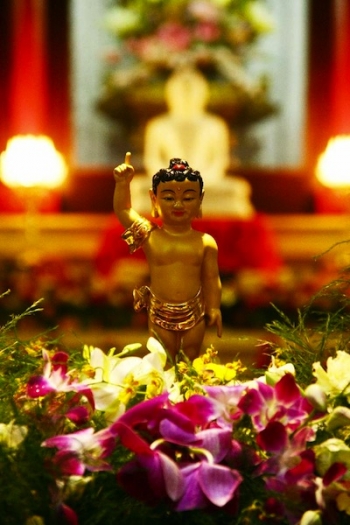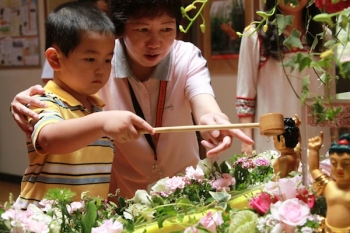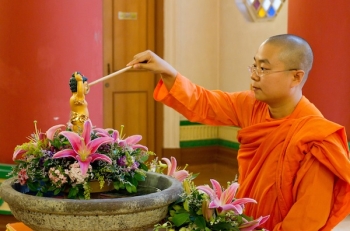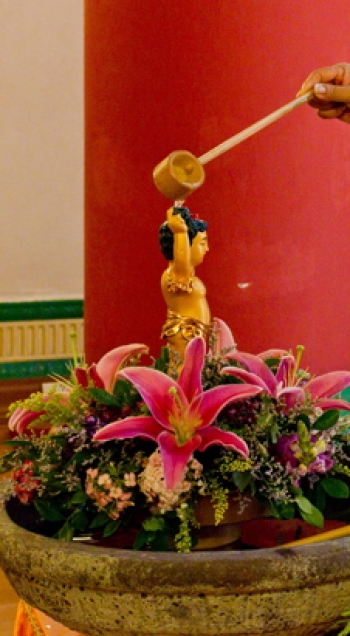Later this month in April and early May, people across the world will celebrate Vesak in many different ways, but they are bound together by a special commemoration in honoring the young Gautama. One particular ceremony during this festive time is called: “Bathing the Buddha”. To bathe the Buddha is to pour scented, blessed water over an image of an infant Prince, who has his right forefinger pointed upwards and left forefinger directed downwards. The Prince’s image embodies the enlightened presence of the Buddha. This ritual comes in different forms in each country that it is practiced in, but they are all throwbacks to a single sacred story. It is a story that brings sentient beings together in a joyful celebration of a promise. That promise is nothing less than the end of suffering and ignorance.
FEATURES|THEMES|Festivals and Teachings
A Vesak Ritual - Bathing the Buddha
Buddhistdoor Global | 2012-04-01 |
 Baby Buddha
Baby Buddha Chinese families enjoy the tradition
Chinese families enjoy the tradition Bathing the Buddha
Bathing the Buddha water ritual
water ritualAccording to the ancient stories, the Buddha was born in a very peculiar fashion. Since his mother, Queen M?y? was standing up – or more accurately, leaning against a sara tree – when she gave birth, the baby sprang from her side, landing right on the ground. He was born clean and radiant. The Prince could already walk, and walk the four points of the cardinal directions he did. Wherever he set his feet lotuses sprang up and blossomed. His right forefinger pointed up to the sky and his left down to the grass. Finally, he spoke, although by this time his mother probably had reckoned that she’d seen everything and wasn’t as surprised as she thought she would be:
“Above heaven and below heaven, none are equal to me. This is my last birth. There will be no more rebirths.”
The legend claims he was then showered generously from the skies by the sacred waters of devas (gods) and n?g?s, semi-divine serpents. In the Chinese tradition they are sometimes depicted as fully divine dragons.
More than two millennia after this miracle, I found myself wondering why the glorious Bodhisattva even needed us, mortal deluded beings that we are, to bathe his image. I’ve come to believe our bathing the Prince is a gesture of welcome, to invite the baby Bodhisattva into this suffering world and give thanks to him for coming. But it’s something more. In the Chinese tradition, laypeople are invited to communally participate in the Dharma Assembly of Bathing the Buddha. But in the Mah?y?na tradition, ??kyamuni is the unique Buddha of this world, with many more simultaneously in others. So Buddhists and people involved with Dharma communities are invited to make offerings to establish fruitful karmic conditions with infinite bodhisattvas. Worship, prayer, and devotion will empower us to beseech all Buddhas to aid them in the project of building peaceful communities of faith.
The meaning of bathing the image of the Buddha is multifaceted. We guarantee to cultivate our spiritual maturity. We vow to attain purity of body, speech, and mind in the three times of past, present, and future. In the Chinese tradition the vow is very ambitious: to be reborn life after life to help suffering beings until one becomes a bodhisattva and then a Buddha. This year in 2012, we welcome little Siddhartha Gautama into our world again. It might have been his last rebirth 2600 years ago, but I share the confidence of all Buddhists that he’ll always be with us, until all beings are freed from suffering. Is there a better friend, a more compassionate companion, than someone who made a vow eons ago to become one Buddha among many?
The least we could do is give him a refreshing welcome – just don’t presume to give the World-Honored One a bubble bath this May.
For Online Buddha Bathing: http://www.buddhistdoor.com/buddhabirth/index_eng.php

Categories:
Comments:
Share your thoughts:













